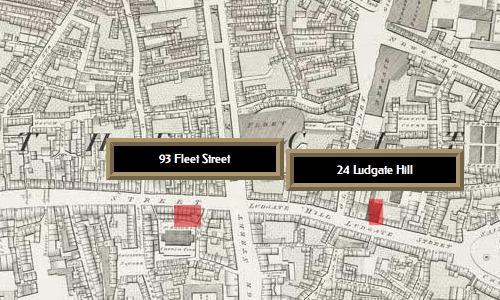13/19 January 1818: The London Coffee Club & a Busy London Life
London Coffee Club, 24-26 Ludgate Hill, London

Keats goes to the very popular London Coffee Club to dance at least three times in January. Keats this month also goes to a dance at the residence of his friend, Charles Wentworth Dilke, and he attends a modest ball. We know he’s at the London Coffee Club to dance 19 February 1819 and 11 January 1820.
Keats’s social life in London is almost always very full, more often than not resulting from the circle of friends and acquaintances spinning off from his introduction to writer, poet, publisher, and celebrity journalist Leigh Hunt, beginning October 1816. The group includes writers, critics, scholars, poets, journalists, publishers, and artists—some of them prominent or at least established, and all of them very supportive of Keats. This intellectual and artistic network is to a significant degree responsible in forming and pushing Keats’s poetic progress.*
January 1818 is a full month. Besides dining and socializing with friends (including Dilke, William Haslam, John Hamilton Reynolds, John Taylor, Benjamin Robert Haydon, William Hazlitt, Charles Wells, Charles Brown, Joseph Severn—and seeing much of James Rice), it involves going to Hazlitt’s famous lectures; seeing his publisher, John Taylor; reviewing theatre in place of Reynolds; seeing his sister, Fanny, twice; preparing his long poem Endymion for press and taking it to his publisher; and writing some occasional poems.
During January, Keats also has some intriguing meetings with William Wordsworth, perhaps the greatest poet of the age.
Unfortunately, we know almost nothing of what actually transpires, but it is hard
to imagine
Wordsworth not holding forth about the nature of great poetry—his own poetry, that
is. Keats,
too, calls on the surgeon Solomon Sawrey (an expert on venereal disease) about his
younger
brother’s—Tom’s—precarious medical
condition, and in particular Tom’s spitting of Blood
(5 Jan); Tom’s symptoms obviously
point to consumption. Tom does not make it to the end of the year.

Meanwhile, as Keats thinks about his own poetic progress, and while he muses that
he is
perplexed in a world of doubts and fancies
in which there is nothing stable
(13/19 Jan), he says he feels a change in his intellect
: I cannot bear to be
uninterested or unemployed, I, who for so long a time, have been addicted to
passiveness.
As a result, he says he is getting at it, with a sort of determination
and strength
(23/24 Jan).
Some of this conflated doubt and resolution results from Keats imagining a time when he is at last done with his self-imposed poetic trial, his long poem Endymion(he begins it in April 1817; he is done with it in April 1818). There is also the sense that he does indeed feel his poetic purpose and artistic depth is growing—and mainly growing away from the sentimental, affected poetry of sociability associated with Hunt. Although a few passages in the 4,050 lines of Endymion point toward a maturing voice (though less to a poetic purpose), in the process of revising and correcting the poem, Keats becomes well aware of its limitations and faults—reading Keats’s eventual preface to the poem is the best pointer to the poem’s frailties and his attitude toward it. Even a couple of reviewers who want to give Endymion a good dressing-down mainly for ideological reasons, also quite rightly point to its rambling purpose and patchy style.
We have to imagine Keats positing the question, What does Endymion achieve? Then we have to imagine him answering: It demonstrates
my dedication to poetry, my perseverance in purpose, but it is something to move not
just on
from but away from. In his own words, he recognizes that although it serves as a
Pioneer
(27 Feb 1818), he admits that overall it is slipshod,
yet diving
haphazardly into the poem made him aware of the Soundings, quicksands, & the rocks
of ill-conceived poetry (8 Oct 1818). In short, he will henceforth avoid those poetic
dangers
in his poetic progress.
[* See here for a flowchart rendition of Keats’s social network and levels of friendship.]

